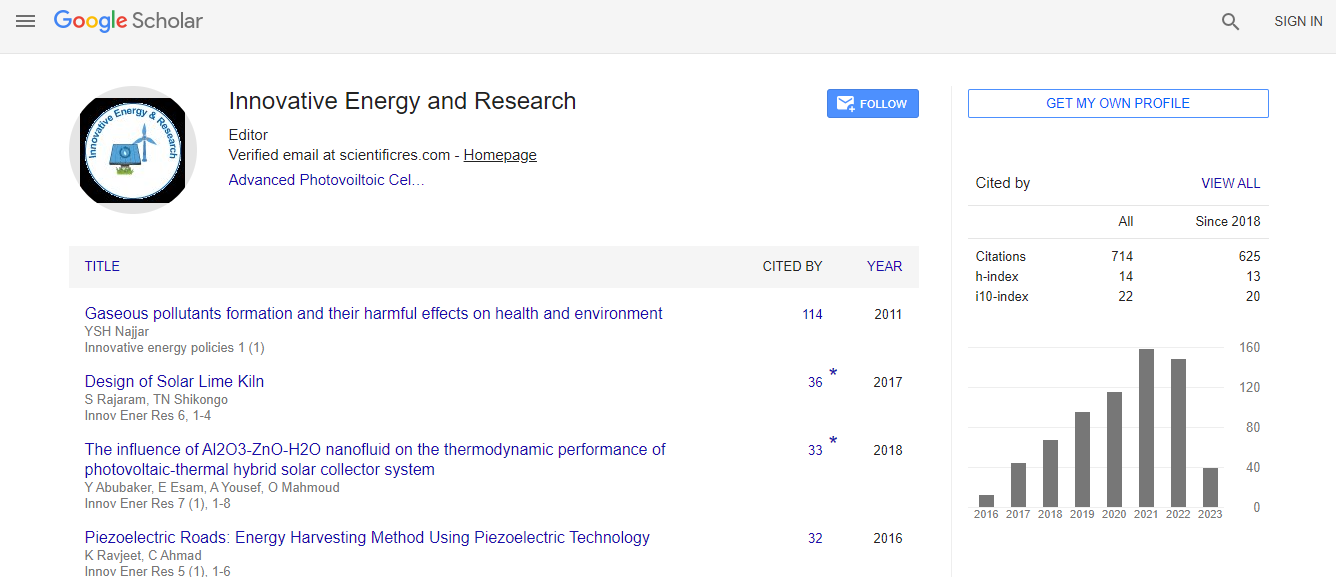Our Group organises 3000+ Global Conferenceseries Events every year across USA, Europe & Asia with support from 1000 more scientific Societies and Publishes 700+ Open Access Journals which contains over 50000 eminent personalities, reputed scientists as editorial board members.
Open Access Journals gaining more Readers and Citations
700 Journals and 15,000,000 Readers Each Journal is getting 25,000+ Readers
Google Scholar citation report
Citations : 712
Innovative Energy & Research received 712 citations as per Google Scholar report
Innovative Energy & Research peer review process verified at publons
Indexed In
- Google Scholar
- Open J Gate
- Genamics JournalSeek
- RefSeek
- Hamdard University
- EBSCO A-Z
- Publons
- Euro Pub
- ICMJE
Useful Links
Recommended Journals
Related Subjects
Share This Page
Evaluating onshore and offshore wind energy feasibility for State of Texas
Joint Event on 2nd International Conference on Renewable Energy and Resources & Energy Materials and Fuel Cell Research
Miyako Nakayama
University of Idaho, USA
Posters & Accepted Abstracts: Innov Ener Res
Abstract
Due to the environmental concerns from the use of traditional fuels such as coals, the US Environmental Protection Agency (EPA) is currently requiring power plants to meet air pollution regulations, which could cause power shortages and even blackouts in the state of Texas. The purpose of this study is to evaluate the feasibility of using onshore and offshore wind turbines (WTs) in Texas based on levelized Cost of Energy (LCOE) analysis. This study is based on a scenario that multiple wind turbines can be installed in available onshore lands and offshore seas of the state of Texas. A commercial WT is selected for both onshore and offshore situations and the corresponding LCOEs were analyzed. Secondly, the maximum number of WTs which can be installed in the available areas was determined based on a spatial distance criterion. Lastly, the maximum annual energy output and the maximum average power output for both situations in Texas was estimated. Although offshore WTs are considered to be more promising technology which can produce more energy and power these days, our results showed that the selection of the two wind turbine types may vary using different indices and number of turbines. 1. In terms of LCOE, onshore WT is more economical due to the lower LCOE. 2. In terms of Capacity Factor, offshore WT is more power-efficient due to the higher capacity factor. 3. In terms of Annual/Average energy and power output A. For a single WT, an offshore WT produces more power and energy than onshore WT. B. For WT farm, onshore WTs produce more power due to more number of turbines that can be installed in available windy land.Biography
Miyako Nakayama obtained her business bachelor degree in Hosei University in Japan in March 2015. Since 2015 fall, he has been majoring in Mechanical Engineering to seek a second bachelor in the University of Idaho. In summer 2017, as a sophomore student, he had completed comprehensive research on Wind Energy based on extensive literature reviews, which covers both technological and business perspectives and has been on the process to publish her research paper.
E-mail: naka6494@vandals.uidaho.edu

 Spanish
Spanish  Chinese
Chinese  Russian
Russian  German
German  French
French  Japanese
Japanese  Portuguese
Portuguese  Hindi
Hindi 
